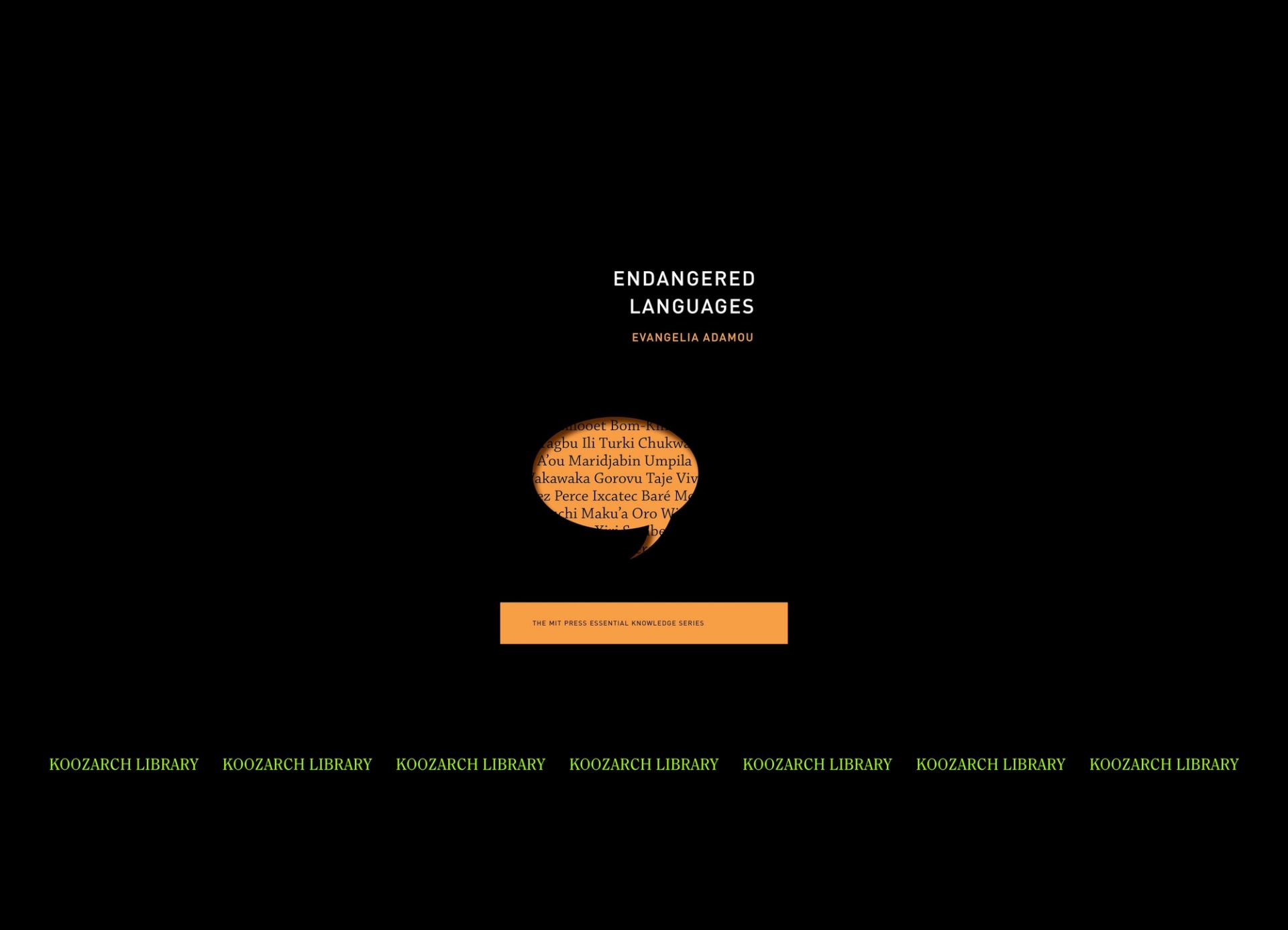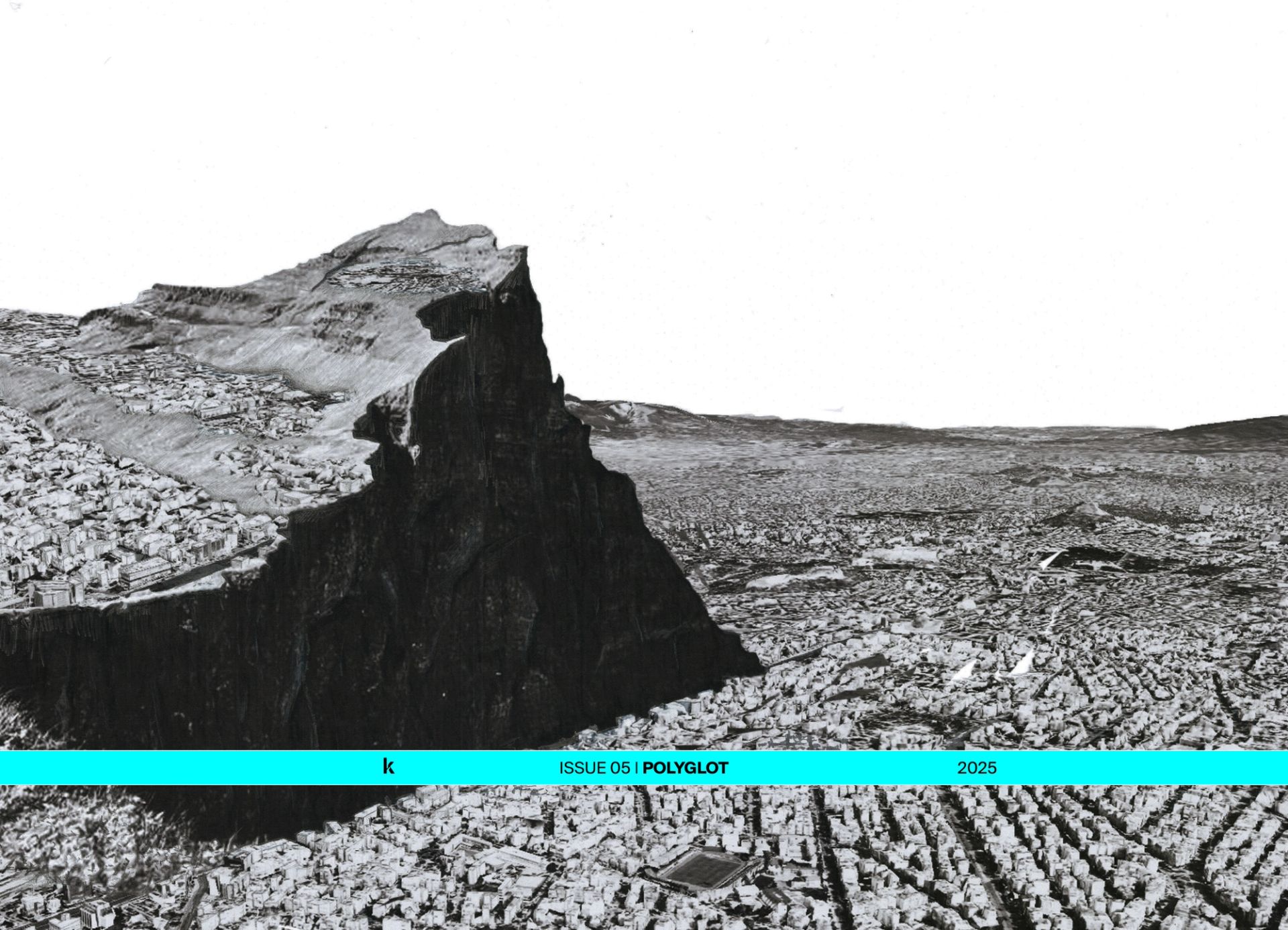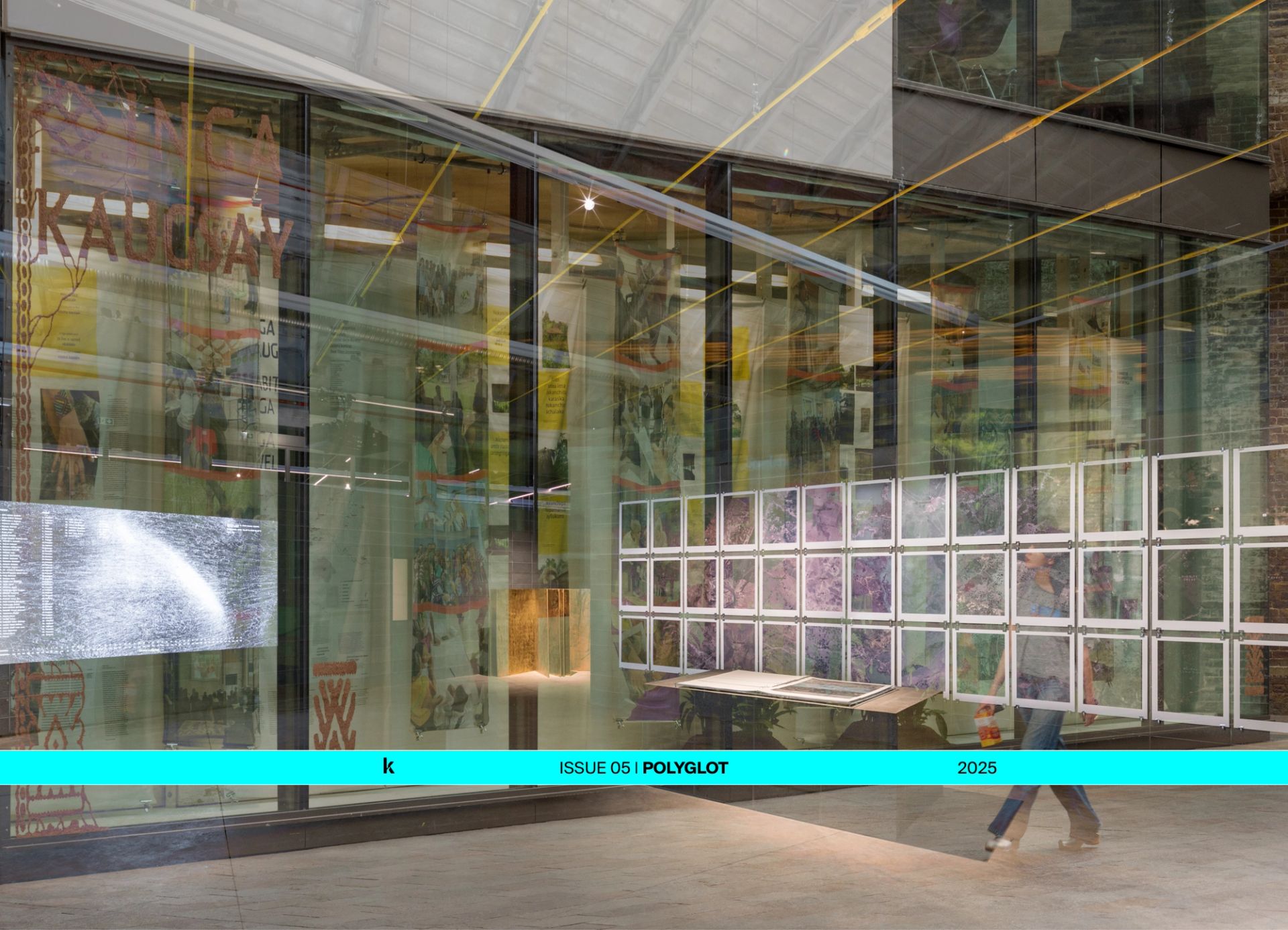Drawing from three collectives and counting at least 18 collaborators within its organising team, it is no surprise that this year’s contribution from Scotland profits from a polyphonic multitude of languages and perspectives, from which to read the significance and meaning of our relationship with landscape. Kooz sits down with co-curators Alyesha Choudhury of /other, Kristina Enberg of -ism Magazine and other members of the curatorial team.
KOOZ The project A Fragile Correspondence, presented by Scotland + Venice within the context of the 18th International Architecture Exhibition – La Biennale di Venezia, questions whether a closer relationship between land and language might help architecture to be more attuned to the environment in which it operates. What prompted this question, and how does it respond to Lesley Lokko’s curatorial theme The Laboratory of the Future?
ALYESHA CHOUDHURY (/OTHER) The question was prompted by the common thread of the power of language between the three main collectives which form the curatorial teams: Architecture Fringe, -ism Magazine and /other. This project was conceptualised in the summer of 2022, after Andy Summers and Neil McGuire of Architecture Fringe approached -ism Magazine and /other, but it draws from a culmination of layers of collaboration over the last 4 years. The relationship between land and language has been a thematic element across the many exhibitions, magazine issues, festival editions, panels, installations and essays that we have worked on together and as independent collectives: it only made sense to use our prior research as a foundational element to develop a project for the Scotland + Venice exhibition.
"When considering what a Scottish representation can have in the context of the Biennale, we began to explore the unique landscapes Scotland has in comparison to the rest of the United Kingdom."
- Alyesha Choudhury, /other
When considering what a Scottish representation can have in the context of the Biennale, we began to explore the unique landscapes Scotland has in comparison to the rest of the United Kingdom. “Highlands, Islands and Lowlands” became a catchy hook to describe the terrain across the country; through further investigation, we found that each terrain had a strong affinity to myriad folklore, ecology and localised knowledge.
"It became very clear that Scotland’s relationship with land is defined by the languages spoken across the regions."
- Alyesha Choudhury, /other
From our first site visit to Abriachan in Loch Ness, we were introduced to Dr Mairi McFadyen and Ragnaid Sandilands, who graciously shared their research of the intrinsic relationship that the local community has with the Gaelic language, intellectualised further by the folklore and history that surrounds the Highlands. From this point, it became very clear that Scotland’s relationship with land is defined by the languages spoken across the regions. This became a framework to apply to the following locations, as we found that there were parallels of the relationship between Loch Ness and Gaelic mirrored by that between Orkney and Norn, and Ravenscraig and Scots dialects.
KOOZ In the opening remarks for this years’ Sharjah Architecture Triennial, Lesley Lokko herself reflected on how we do not seem to yet have the language which can help us define and achieve the world as we want it to be. What does this world look like from the standpoint of A Fragile Correspondence? Could you expand on the notion of a new lexicon of terms and definitions explored in your pavilion?
CURATORIAL TEAM For practitioners like architects, landscape architects and local authorities, the new Lexicon is there to help us reconsider the meanings that we apply to many words and phrases that we use. Like ‘development’ for example, a word that reminds us to expand what we see as valuable beyond mere capital and profit, into something more holistic. The Lexicon is woven throughout the exhibition and is used to help frame the correspondence and issues being discussed from each location. The Lexicon also highlights a lot of key words in diverse languages that have an affinity with the Scottish landscape. These offer alternative perspectives and worldviews. In A Fragile Correspondence, two words that frame the curatorial lens for Loch Ness are:
Extract (English): To remove something, to take it out of its surroundings, especially by effort or force.
Cothromachadh (Gaelic): The act of balancing, finding equilibrium. The root of this term is the word 'cothrom' meaning ‘chance’ or ‘fair play.’ 'Cothrom' itself is made up of two words, 'comh' and 'trom', literally meaning ‘of equal weight’ and by extension ‘opportunity’ and/or ‘equity’. This term acknowledges that there needs to be just chance or fair opportunity for all if there is to be balance.
"Cothromachadh is a Gaelic term that translates to an act of balancing; finding equilibrium, and is rooted in ideas of fairness."
- Curatorial team of A Fragile Correspondence.
Cothromachadh is a Gaelic term that translates to an act of balancing; finding equilibrium, and is rooted in ideas of fairness. Through Cothromachadh we explore approaches to the landscape which seek a more reciprocal relationship and greater balance between humans and the natural environment. In the context of the worldwide climate emergency, the forest communities of Abriachan and Strathnairn on the north and south banks of Loch Ness are our guides to alternative perspectives on economies of use, inhabitation and the cultural stewardship of land.
KOOZ The work is deeply rooted in three distinct landscapes of the Scottish region: Lowland, Highland and Island. How do each of these explore issues rooted in place, while extending global relevance to the cultural, ecological and climatic issues that we face? How are these themes reinforced through the exhibition design?
CURATORIAL TEAM For Highland, we looked at the north and south banks of Loch Ness and how that land is managed and stewarded. The romanticised image of Scotland — first explored in 18th Century literature and art — imagines a landscape that is wild, rugged and empty of people. Modern internationalised tourism and property markets continue to frame Scotland in this manner. This way of seeing predominantly serves the interests of capital and landed power, obscuring the often fraught and violent history of displacement and dispossession. The Highland Clearances (the forced eviction of people to make way for commercial sheep-farming) saw the exploitation of the natural environment through concentrated patterns of ownership for explicit capital gain. The forest landscape has been subject to mass material extraction and deforestation for industry, war, and managed for sport (including deer stalking and grouse shooting), causing severe ecological degradation alongside profound cultural loss. Representing the forest and the Gaelic connection to trees, Loch Ness’s materiality focuses on wood.
"The romanticised image of Scotland predominantly serves the interests of capital and landed power, obscuring the often fraught and violent history of displacement and dispossession."
- Curatorial team of A Fragile Correspondence.
For Island, we’ve been in Orkney looking at the liminal space around the coastline of the archipelago. In Orkney, forces of nature such as the wind and sea are ever-present and play a significant role in shaping the characteristics of human endeavour. Culture and folklore run deep with stories of otherworldly transformations, marked by shifts in form within the liminal space of the shore between the tides. Throughout the centuries, changes in temperature, landscape, coastline and dominant language have fostered a culture of creative adjustment and agile adaptation. The climate emergency is intensifying the force of the natural world, and the heightened response required brings to the fore issues of decentralised political power, energy management, and environmental steward. Focusing on the foreshore — that is, the space that is both water and land — as well as the histories of human use of the land stretching back to neolithic time, Orkney’s landscape is represented through sand and clay.
"Culture and folklore run deep with stories of otherworldly transformations, marked by shifts in form within the liminal space of the shore between the tides."
- Curatorial team of A Fragile Correspondence.
For Lowland, we’ve been working in Ravenscraig — the ex-industrial site of one of the largest steelworks in Europe. Today, the landscape is a place of both industrial scars and environmental resurgence, as the obsolete concrete is cracked by moss and pioneer species such as silver birch and alder emerge across its contours. Ravenscraig’s current condition is often perceived through binary understandings of place, where the absence of the steelworks recalls the past whilst the development plans of new roads and housing jump-cut to the future. Through these binary ways of seeing, the contemporary landscape remains unacknowledged, unseen and is therefore under threat of erasure. Workers of the steel plant were partially made up of migratory Irish and Highlanders, while Scots, English and Gaelic fed into what is known today as West Central Scots. The term Saunt derives from this linguistic landscape, translating as a mysterious and ethereal disappearance. How can we acknowledge the fragile condition between erasure and saunt? The former signifies permanent and deliberate eradication, while the latter allows memory and spirit to remain or linger. Ravenscraig condenses stories of labour, community, economy, regeneration, and dereliction. Opposing its erasure, we present and acknowledge the landscape in its current authentic condition. Encouraging visitors to confront and rethink existing grains, rather than make anew, Ravenscraig is represented through use of recycled materials with an emphasis on metal.
"The term Saunt derives from this linguistic landscape, translating as a mysterious and ethereal disappearance. How can we acknowledge the fragile condition between erasure and saunt?"
- Curatorial team of A Fragile Correspondence.
KOOZ In particular, the research on Orkney examines how the local population have for centuries negotiated the forces of nature — namely the dynamic and powerful sea — as an example of an evolving relationship between people and place, anchored in a deep understanding of the natural environment and steeped in community resilience. How does this specific case study come into dialogue with the context of Venice and its lagoon?
KRISTINA ENBERG (-ISM MAGAZINE) Seen through the lens of contemporary travel and tourism, Orkney might seem like a landscape located at the fringes. However, the position and shape of this archipelago means that it has long been regarded as a safe haven for travellers of the seas in northern Europe for centuries, offering shelter to ships taking refuge by the Peedie Sea of Kirkwall and Scapa Flow. In fact, human presence in Orkney can be traced back 8500 years. The island landscape, as in Venice, has been partly shaped by humans in order to inhabit marshlands and to connect smaller islands.
"The close relation with the sea means that the community and its coastal heritage are under urgent pressure to navigate the impacts of climate breakdown, as intensified storms and rising sea levels put a strain on the dialogue between land, water and the society of species that sit between."
- Kristina Enberg, -ism Magazine
The close relation with the sea also means that the community and its coastal heritage are under urgent pressure to navigate the impacts of climate breakdown, as intensified storms and rising sea levels put a strain on the dialogue between land, water and the society of species that sit between. Sites of archaeological value in Orkney — such as the 5000-year-old Skara Brae settlement — are now at risk of being claimed by the sea. Poignantly, there is research indicating that Skara Brae was abandoned by its inhabitants due to climate change around 2500 BC, showing the impact that shifting temperatures can have on the survival of a civilisation. There are parallels that can be drawn between present and past, lessons to be learned which are now at risk of being lost in Orkney and many other places through coastal erosion. But being at the forefront of the effects of the climate crisis, Orkney is also leading innovation to become climate resilient with the European Marine Energy Centre located in Stromness, researching and developing ways in which to source wave and tidal energy, alongside a well-established programme of harnessing of wind energy within the community.
"The intent of this exhibition was to start a dialogue between places that are facing similar issues and create opportunities for exchange of learning in the face of our rapidly changing environments."
- Kristina Enberg, -ism Magazine
When presenting this location and dialogue within the exhibition at Venice on San Pietro di Castello, itself one of the islands that make up the city, similarities between the two locations become evident despite their respective positions at opposite ends of the European continent. For instance, the historic development of human settlement in a sheltered sea landscape, the palimpsest of coastal heritage mixing with the everyday life of the present — all of which is now at risk of being lost due to flooding. The intent of this exhibition was in many ways for these parallels to be made by visitors, to start a dialogue between places that are facing similar issues and create opportunities for exchange of learning in the face of our rapidly changing environments.
KOOZ The exhibition culminates in a reading room which hosts the project lexicon and a digital interface, where visitors are invited to interact with the text and resources to contribute their own words and descriptions for place, land and landscapes that are important to them. Six months after this process started and at a time when it is coming to an end, what did this interaction yield? What other definitions does it propose?
ALYESHA CHOUDHURY (/OTHER)As mentioned above, A Fragile Correspondence is a culmination of the curatorial collaboration between the Architecture Fringe, -ism Magazine and /other; this is further enriched by the collaboration between our nine Participants, who responded to the framing of our three locations. This makes the exhibition dense with information and artistic responses, so we were very aware that visitors to our pavilion — most likely who had also been to exhibitions across the Giardini and Arsenale — may appreciate a quiet moment to ponder. It was very important that the exhibition design allowed for a space of reflection and resources, and we were very lucky that the Docks Canteri Cucchini has a beautiful view on offer too. By providing a table, a stool, a pen and a paper with a blank prompt, this simple interactive element allowed for visitors to write and sketch their own additions to the lexicon. It became clear that our exhibition, although rooted in Scotland, allowed for the universal understanding of landscapes to be shared across languages and cultures. From the opening weekend to the closing weekend, the table has taken on a life of its own.
Bio
Curatorial team
The Architecture Fringe is a self-initiated non-profit volunteer-run organisation which explores architecture and its impact within our collective public life. Their primary objective is to expand and open up architectural culture by creating new work and commissioning new voices.
ism architecture magazine is an independent publication based in Glasgow with a desire for bold and critical reflection on the built environment. Its ethos revolves around using the written word to create a platform of accessible writing for voices of diverse backgrounds.
/other is a collective of POC (people of colour) creatives that centres the marginalised individual within architectural discourse. Their exhibition and curatorial work is grounded in methods of collaboration and critical questioning, aiming to present a contemporary culture of diverse expression.
Federica Zambeletti is the founder and managing director of KoozArch. She is an architect, researcher and digital curator whose interests lie at the intersection between art, architecture and regenerative practices. In 2015 Federica founded KoozArch with the ambition of creating a space where to research, explore and discuss architecture beyond the limits of its built form. Parallel to her work at KoozArch, Federica is Architect at the architecture studio UNA and researcher at the non-profit agency for change UNLESS where she is project manager of the research "Antarctic Resolution". Federica is an Architectural Association School of Architecture in London alumni.





